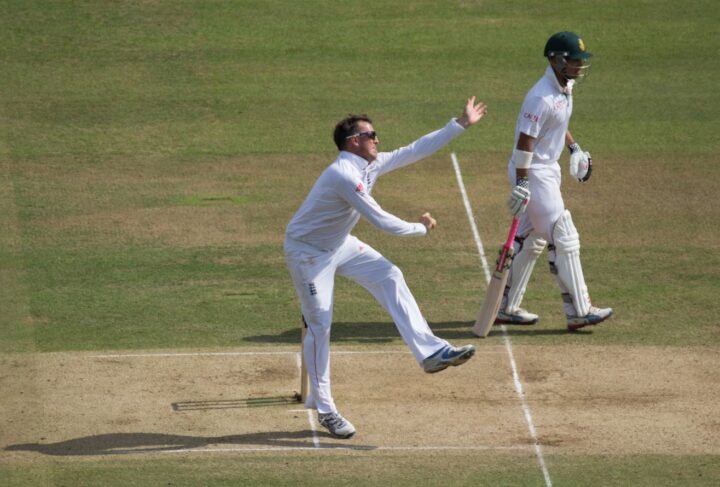Today we welcome new writer Richard Willmett to TFT. He has some thoughts on T20 and why, despite its apparent entertainment value, the format could be made so much better …
There wasn’t a great deal left by the time COVID had swept through; the pernicious virus couldn’t help itself. Rather than simply being content with killing swathes of the population it sought to compound its horrific physical and economic effects by also attacking some of life’s peripheral distractions, the sort which bring richness to us all. Amongst many other things, COVID wanted to kill the cricket season.
And it made a decent fist of it too. Back in March, England’s tour to Sri Lanka was abandoned before the Tests could be played. Building on a theme, the County Championship, hitherto only susceptible to Hitler’s jackboot (and Colin Graves’ leather-look grey slip-ons) was put on hold for the year. In a major change of plans, Graves was even forced to shelve his own novel virus – a version of the game seemingly designed to promote the twin benefits of decimalisation and the eating of crisps.
The remnants – that which could be salvaged in the springtime rush to batten down hatches and sanitise every surface – was a curious melange. England would welcome the summer tourists as planned, though they would be reduced to playing in front of the sort of attendances only witnessed in nine of the twelve Test-playing nations. Domestic tyros would be afforded the opportunity to run in for both some red ball games and the T20 Blast[1]. Aside from these, the only other outlet afforded to the newly time-rich and cricket-hungry masses would be the Caribbean Premier League and, as a consequence, I was rather keen to see as much of it as I could.
I was hoping that increased familiarity might lead to some form of personal conversion. T20 had not exactly passed me by; I’d watched a reasonable amount since its emergence in 2003 but had always been unable to fully engage with tournaments other than the Blast on an ongoing basis. The IPL seemed to arrive just as teaching commitments were ratcheted up to DEFCON 2 in preparation for the summer exams and the Big Bash – as well as being commonly broadcast at times when I lacked consciousness – tended to lose out to the medical imperative that requires me to follow every down of the College and NFL football seasons. Something had to give, and it always ended up being franchise cricket.
I resolved that this year, however, I would fully engage. With little alternative to sate the appetite, save for some intermittent forays onto the gloomy fields of Old Trafford and Southampton, my anticipation of the CPL reached the sort of level I commonly reserve only for takeaway deliveries and the latest Le Carré. Being largely unfamiliar with the CPL I did my research on the essentials and discovered in the process that “Zouk”, after which the St. Lucia franchise is named, is a form of regional music – the sort that Paul Simon would likely have embraced in the 1980s if his wanderings had taken him beyond South Africa. Furthermore, I learned that “Tallawah” – the identifier of the Jamaican team – refers to the island’s inherent fearlessness, the word presumably developed for anyone who went within eight feet of Sabina Park’s 1998 Test strip. Suitably conversant in the nomenclature and having boned up on the history of the tournament, I settled in to enjoy the season.
I regret to say that at the time of writing – twenty four games later – I am still waiting.
I certainly haven’t expected to be blown away by every contest, not least owing to the limitations COVID has brought. There has been a slew of top-level withdrawals of overseas personnel – travel restrictions and personal concerns having robbed the tournament of the likes of Hales, Stoinis and Nortje, all of whom would have added lustre to proceedings. Having to play the tournament at two Trinidadian hubs – the Brian Lara Cricket Academy and the Queen’s Park Oval – means that conditions for play have been less varied than they might be. These factors are compounded by what is clearly the biggest restriction, the lack of a crowd. This summer we’ve all been forced to become accustomed to contests denuded of both roaring cheers (sadly) and the Barmy Army’s metronomic renditions of “Don’t Take Me Home” (happily), but this format in particular is robbed of a key part of its essence when the seats serve only as a convenient hiding place for recent boundaries.
None of this can be helped, of course. That there has been any cricket to watch at all is undoubtedly a wonderful achievement and firm evidence of the determined resilience possessed by those responsible for the CPL. However, sustained viewing of franchise T20 for the first time has given me the chance to contemplate the offering in ways I have not before and, sadly, that rumination has led to a number of uncomfortable and inescapable conclusions.
This all started when I couldn’t work out why I was so bored. Game followed game without my pulse being raised in any meaningful way and I struggled to see why. Some of the contests had a modicum of dramatic tension as scores flirted in close proximity with one another. However, despite such relative highlights I couldn’t motivate myself to care. I kicked around a host of potential reasons as to why. Perhaps I possessed a newly dispassionate perspective, brought on by living in a world with COVID? Maybe the lack of tangible off-field engagement was too great to overcome? It could be, of course, that my lack of connection was simply evidence that I possessed no soul whatsoever… What I came to realise, however, is that the problem was something much more prosaic and yet also much more fundamental. The games failed to spark my persistent interest owing to the near-complete absence of cricket’s essential contest.

The most basic element of our game is the contest between bat and ball. This is what has always provided my continued appetite over three decades for what the uninitiated often dismiss as a repetitive, boring procession. In red ball cricket the unfolding of most deliveries is predicated on the notion that the bowler – the strike bowler – is searching to find a way past the batsman’s defences. The varying of speed, angle of attack, swing and so on is largely designed to find a way to take a wicket and it is only occasionally intended to achieve much else. Aside from when a team is 312-2 and the bowlers are heading for a new ball in six overs’ time, there are few situations which can be dismissed as non-threatening for a batsman. Each ball matters; as a fan you don’t want to miss a single one and your attention is consequently held.
T20 reverses that contest. In their admirable Wisden Book of the Year Cricket 2.0: Inside the T20 Revolution, Tim Wigmore and Freddie Wilde rightly identify this as a “paradigm shift”. They point out that at the moment of its creation, this format ensured that “defence ceased to matter”. The batsmen, newly-capable of shots only seen fitfully before 2003, became the predators. The security those batsmen now feel owing to the reduced value of their wicket – all ten only having to last 120 balls, rather than two days – grants a logical license for animalistic exuberance. The bowlers, consequently neutered, often wander around with the air of cuckolds, no longer fixated on the production of a glorious jaffa, but rather on that of the standard dot ball. They rarely seek to splay the stumps or tempt the parsimonious opener to flash at a lifter outside off stump – they care only for that dot. Reducing the scoring rate is the supreme goal. When wickets are forthcoming, they invariably involve a mistimed heave into the outfield or a looping dolly to the covers. The default is for the batsman to give his wicket away – in a manner that would have led to punishment when I was at school – rather than having it forcibly taken from him.
The payoff for this shift is a display of attacking batting intent which would gladden any heart. The well-struck lofted drive, thudding compellingly into the concrete stairs of the upper deck is undeniably something worth seeing. The agility and skill required of the batsman to send the ball off on its unlikely trajectory cannot be simply dismissed as a slog – it takes talent. However, when the broadcasters tell you that Kieron Pollard’s smite into eternity is the 124th Hero Maximum of the tournament, it feels somewhat less impactful. You even start to question whether or not you might be able to score a Hero Maximum or two of your own, given the consistent diet of wide-ish long hops and full bungers that the bowlers, desperate to stop the haemorrhaging, are reduced to serving up.
To force bowlers to work against every instinctive part of their nature in an effort to deliberately produce balls just bad enough they can’t be hit, feels like a cruel experiment indeed. And to be genuinely, consistently entertaining action has to be slightly unexpected and these barrages are anything but. As viewers, we have been spoiled by the expectation of dazzling attacks, to the point where they now barely register. To make matters worse, the pitches – on official insistence – are deliberately prepared to favour the hitters, prioritising the sponsors’ visibility with those boundary ads over the quality of the sport and to please a boundary-hungry demographic on whom the beauty and subtlety of the original game seems entirely wasted. And so, the situation perpetuates itself.
I am not a zealot for the red ball. I get as bored as the next person when it’s 312-2 and the road prepared is performing as advertised. However, when stuck temporarily in the doldrums I know a Test will usually pick up, and that the genuine contest between bat and ball will be back. The same cannot be said for T20, sadly.
Despite my annoyance at what I see as the counter-intuitive bowler-batsman relationship, I hope that I am not an example of those people Wigmore and Wilde identify as perpetuating “the inherent snobbery…within the sport”. I don’t want to malign T20, I really want it to work. I want it to be better; to provide more of the fascination I experience when I watch longer forms of the game while still attracting those it currently delights. I believe it can do this.
Short form cricket is not going away, at a club, national or international level and it is evidently hugely popular worldwide. However, the game is also often eminently forgettable. Contests, even enjoyably close ones, rarely live long in the memory and it is for that reason that I want the cricketing world to turn its thoughts to tweaks of the laws and the setup of T20 which might stop the product being so disposable and so formulaic.
How can we tighten the contest between bat and ball in just 120 deliveries? Might it help to relax the stipulations requiring pitches to be prepared as tedious featherbeds, little more than launchpads for artillery bombardment of punters in the stands? Is there merit in rewarding the batting side with a certain number of bonus runs at the end of their allotted overs if they still have wickets in hand? Is it desirable to allow two of a team’s bowlers to have an allocation of five overs each, rather than four, as suggested by Shane Warne? Maybe we could try a combination of all three of these ideas, just for starters? There are a thousand different potential changes which could redress the current imbalance without altering the fundamentals of the game in terms of length. Such changes could genuinely make this spectacle – cricket’s most user-friendly, accessible and lucrative version – not only more exciting but also, crucially, much more engaging.
Far from wanting to tear it down, I want to enhance it. Who’s with me?
Richard Willmett
[1] A competition with the survival instincts of the sea sponge that will still be filling venues and yet disappointing administrators long after human life is extinct.









Not really with you but your observations of T20 are rather good and many comments spot on. I see no harm in trying any or all of the ideas you suggest, it can only go one way and that is up!
I’m great fan of the T20I WC but find any other T20 unwatchable. The WC benefits from scarcity and teams that mean something. I’d rather play golf or watch the garden grow than watch franchises. I like some of Tim Wigmore’s work but he’s an arse calling this snobbery, it’s having some quality control. I’m alienated from watching modern golf for the same reason, I don’t want to watch a range-hitting tournament between spoilt rich boys. If the authorities really wanted to make T20 more attractive the obvious first step is over rates but they want the gaps for advertising and to allow more betting so it’s clear where their priorities lie.
Dean Jones would have been a great T20 cricketer and I wanted to add a bit more about his sad early passing (from a heart attack, you know them, one of the real big killers that we don’t shut down everything for). Jones was incredibly unlucky to play only 52 Tests. He scored two centuries in his last four Tests so wasn’t dropped because of a lack of form. His last tour was when Australia won 3-0 in SL despite conceding a first innings’ deficit in every game, one of the game’s greatest ever feats. Jones’ personal gretest achievement was scoring two centuries in a Test against a Pakistan attack of Wasim-Waqar-Imran-Mushtaq and when only one other Aussie batsman (Mark Taylor) could make a fifty. Jones captaining Derbyshire to second in the 1996 CC was another awesome achievement. They only didn’t win it because of two defeats against Warwickshire and Northants – the former was to a Penney-Giles’ partnership when the game seemed there for the winning and in the latter Curtly Ambrose took 11 wickets (the seldom-mentioned postscript to the wristband incident, Curtly having an elephantine memory for not forgetting grudges). Derby sacked Jones part way through the following season which I’m afraid says everything about how some counties are more at ease with comfortable mediocrity than with dealing with an abrasive achiever like Jones. Leicestershire won it which shows how much the world has changed that the CC could have a Leicester-Derby one-two which is as about as likely now as Everton or Villa winning the Premiership. A quarter of a century later, these clubs are more likely to be wound up than win anything which is time passing but not “progress”.
Hi Simon. I’ve edited out the Covid-19 aspect of your comment because I don’t want to get into the subject. It’s emotive and has sadly become politicised too. I’m sure Richard talks about Covid simply to provide context and / or reflect the mainstream view rather than to support any party line. Sorry about taking this measure.
A good observant article. As for the changes well yes, but you could tinker around all you like with the rules to make T20 more “exciting” , but the basic problem with it for me is that it’s too short to be effectively be called a “game of cricket”. It cannot provide the highs and lows, the strategies, the long burn over 4/5 days that a shall we say normal game usually gives you. Sixes, however audacious becoming meaningless when you get 15 or so in 40 overs. You don’t savour the Botham six ” into the confectionary stand and out again” for example. It really is designed more for the boozy Friday night hoards, the McDonald’s rather than the Gourmet meal. But the 100 is coming (possibly) …. The Greasy Spoon?
As for Covid this year and outdoor sport, well as among other jobs an ex H&S Officer, there is no possible way in a Risk Assessment that I could say that 2,500 Spectators in the Oval for example, 25000 capacity, outside and socially distanced, carefully monitored, could by any imagination be any more than extremely low risk. Compared to pubs, Universities, Restaurants, street protests, and even indoor gyms, it barely registers on the risk scale. I don’t know who does Boris’s Risk Assessments but whoever it is hasn’t a clue.
One idea I’d like to raise is the possibility of making batsmen retire at 50. We can debate whether they should be allowed to return if their side reaches 9 wickets down. Obviously this might make it tempting for the tail to get out deliberately!
If bowlers are restricted to bowling 4 overs then why shouldn’t there be restrictions on batsmen too? It seems unfair if you really think about it. Either restrict both or restrict neither. Just a thought!
Sorry James I have mentioned the dreaded Covid but in the context of spectators at sport. But edit if you wish.
Longer boundaries would help…
Any cricketing contest is better the closer the balance is between bat and ball. White ball cricket has always favoured the batsman, being played out on flat tracks with rules limiting a bowler’s ability to make an impact and played with a ball that loses swing and seam pretty early on. It is ironic that a game intended to forge attacking play has become an almost totally defensive excercise on the part if the fielding side. This inevitably reduces variety and produces a pretty formulaic structure to every game. It has undoubtedly produced different skill sets for batsmen and bowlers alike with reverse sweeps, ramps and the much vaunted slower ball to the fore, but the game as a whole has no real drama until the last few overs, especially ODI’s which often go to sleep mid innings as both sides seek to establish a position so as not to lose control of the game. I have long advocated a return to the original 40 over format to reduce this lull in proceedings.
As white ball cricket is about runs not wickets, bowlers will always take a back seat, being seen by the games organisers as spoilers if they have too much success. The only thing it has produced to the general benefit if the game is an undoubted improvement in out fielding standards, though slip catching is still something of a lottery as players get little practice at this in the white ball format.
All white ball cricket would benefit from having a bit more variety in the pitches. The flat track and short boundary combination that leads to 180 vs 180 or 350 vs 350 is fun to watch every now and then, but you lose out if every game is like this – its like a diet consisting only of steak – eventually you hanker for some vegetables.
We need more variety in pitches (slow turners and greentops as well as roads) and in the field dimensions. Then the best multi-dimensional cricket side would win. And I know there will be ignoramuses claiming that this is “boring” and “not what the kids want to watch”, but actually I think they’re just not giving kids enough credit. If you don’t appreciate the intrinsic variety and variability of cricket’s different formats, contexts and settings,, then I don’t think you appreciate cricket at all.
World cricket has put all its eggs in the Indian basket…. the Indian ecomy just shrank by the second most of any country in the second quarter of 2020 (only Peru was worse)….
It’s a small part of the misery that stat entails but it can’t be good news for cricket – unless elite sport is now so detached for any kind of economic reality that it won’t make a jot of difference.